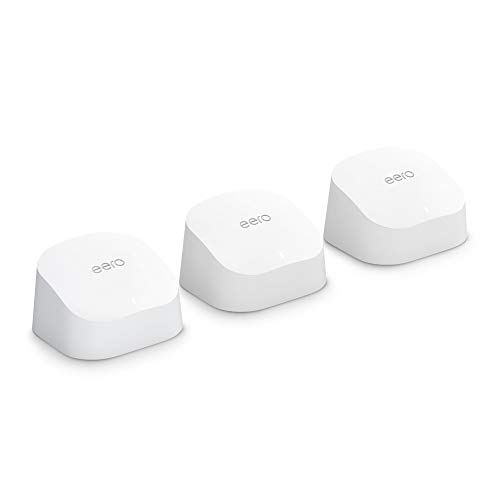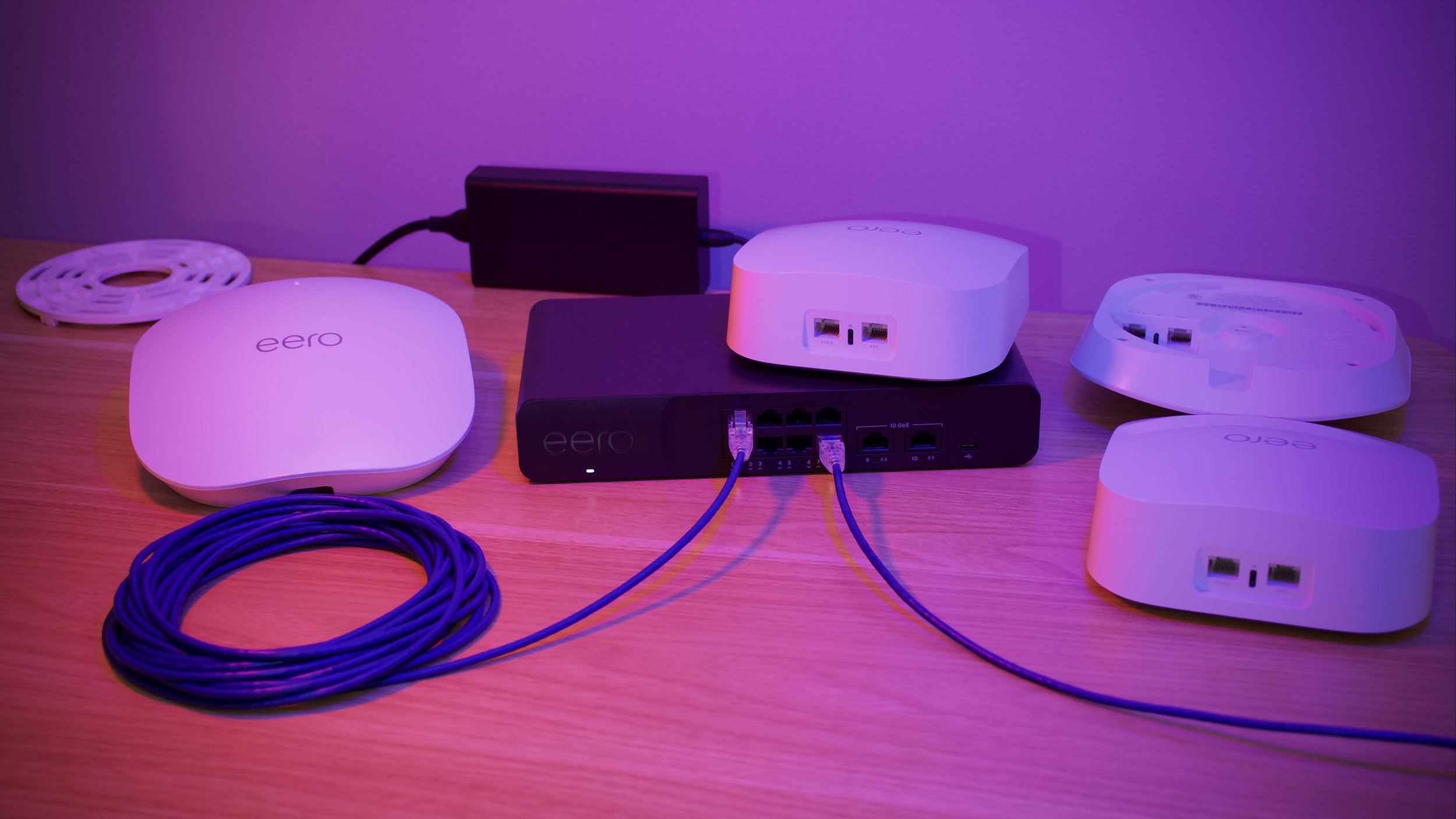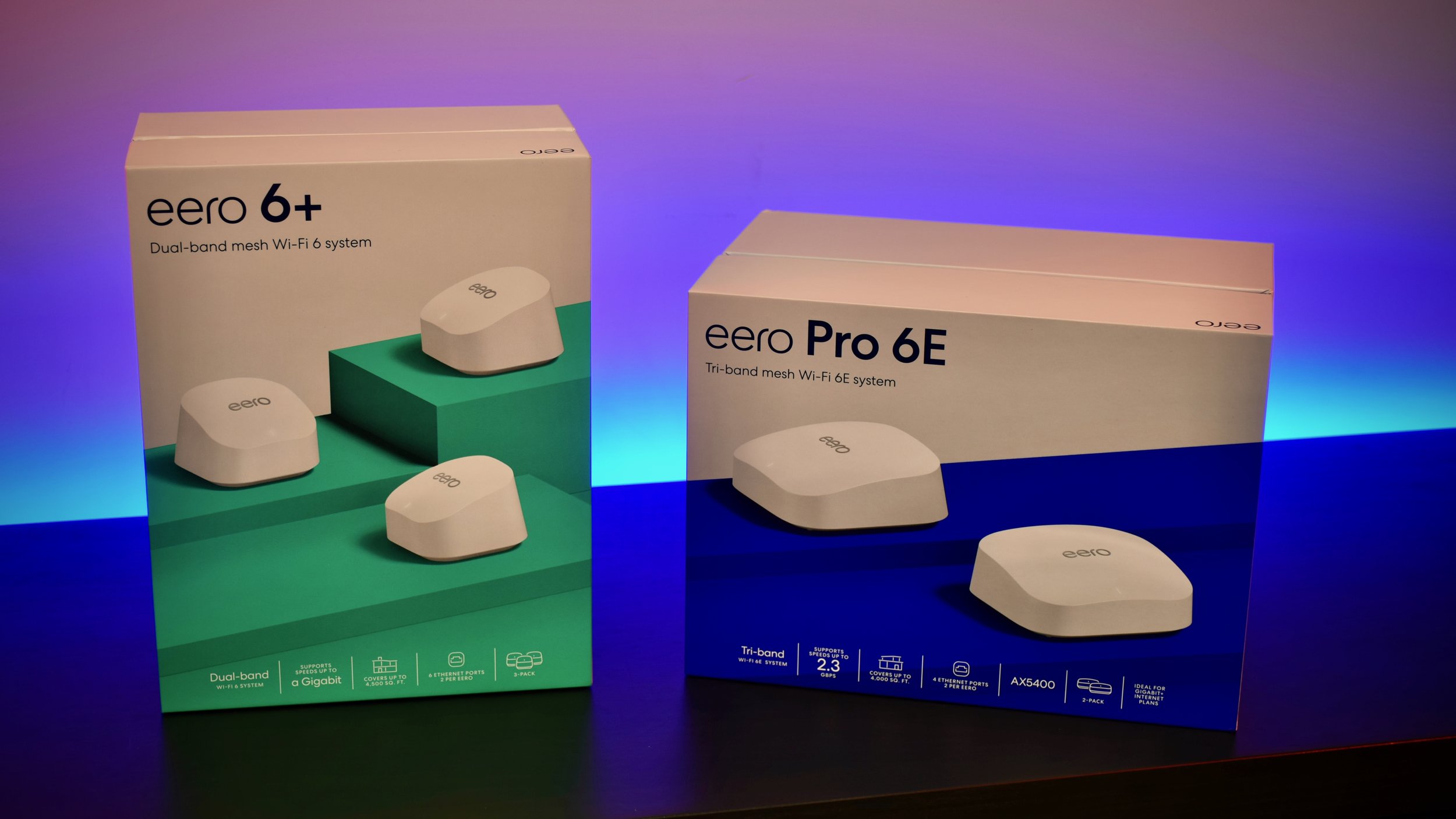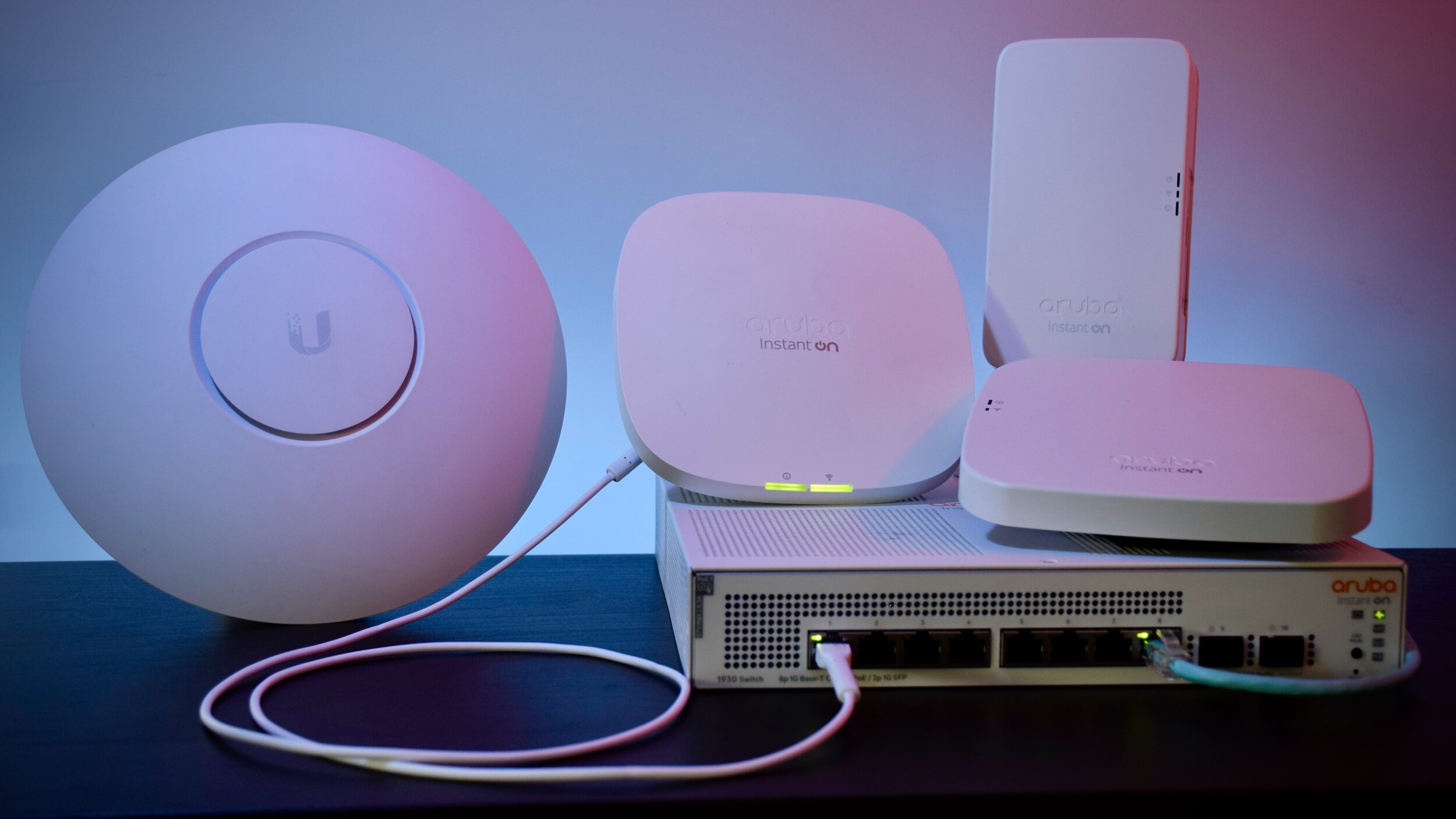eero 6 vs. eero Pro 6: Wi-Fi 6 Model Comparison
Originally Posted: February 11th, 2021
Last Edited: April 19th, 2022
TL;DR:
This review covers the eero 6 and eero Pro 6 from 2020, for speed tests and updated comparison, see my review of the eero 6+ and Pro 6E
If you have a smaller home or an Internet connection under 400 Mbps, one or two eero 6 units are all you need
If you have a bigger home, a lot of devices, or a faster Internet connection, stepping up to the eero Pro 6 might be worth the extra cost. For most users, wireless backhaul performance is biggest the deciding factor
If you are able to use Ethernet to connect them, the differences between them aren’t as big
eero Pro 6
eero 6 vs. eero Pro 6: Wi-Fi 6 Model Comparison
eero is one of the best known and well-reviewed mesh Wi-Fi systems. Currently, eero have three Wi-Fi 6 models, the eero 6, eero Pro 6, and eero 6 Extender. They also have three older Wi-Fi 5 models. The chart on the right is good reference for some of the specification differences.
eero model specification differences. Image credit: eero.com
All eero devices run the same software, and you can mix and match the different units. You can buy them individually, or in different combinations based on what kit you purchase. To figure out how many you need and which you should get, you need to know two things: coverage area and Internet speed.
The eero 6 and the eero Pro 6 are the two options for your gateway, or main base station. These are the unit that connect to your Internet connection, and which all your other eero nodes connect to. Both the eero 6 and eero Pro 6 feature two Ethernet ports for connecting to a modem, router, or an end device. In a typical eero setup, you would use one of these to connect to, or replace, your existing home router. The eero 6 and eero Pro 6 units can also be used as mesh nodes, wirelessly connecting to the gateway node.
The eero 6 Extender can only be an add-on mesh node, connecting wirelessly to a wired eero gateway. Since the eero 6 Extender does not have Ethernet ports it cannot act as the main gateway. It only acts as a wireless relay, taking the signal from another eero and extending it.
In addition to these three models, you can also buy the previous generation eeros, which support Wi-Fi 5. The 3-piece Wi-Fi 5 eero kit can be a good option for slower Internet connections, or if coverage and cost are the most important factors.
First, Determine Coverage Area
The most important part of picking an eero system is determining how big your coverage area is. eero lists some general recommendations on their website. eero also have a short quiz on their website to determine which kit is right for you.
Small homes and apartments: Since we recommend 1-2 eeros per floor, a great fit would be our eero 6 + eero 6 Extender kit. This set includes one eero 6, which will replace your existing router and connect directly to your modem, and an eero 6 Extender to be placed at another spot in your home to help blanket your home in fast, reliable Wi-Fi.
Most homes: If you have a home that has two or more floors, you will likely see best results from our 3-piece eero 6 kit. Again, the eero 6 will replace your existing router and connect directly to your modem, while the two other eero 6 units can be placed throughout your home to deliver the best-connected home experience.
Larger homes: If you have a larger home, meaning more than three floors, you may benefit most from purchasing a mix of our eero packages. Also, you can buy an additional eero 6 or eero Extender individually.
Wired homes: If your home is wired for Ethernet, the best fit is our eero Pro 6 Kit. This set includes three high-powered eero 6 Pros, each of which feature a tri-band radio and two Ethernet ports. The eero Pro Kit is also a great fit if you want the ultimate in overall network performance.
In my modestly-sized 2 story house, two eero units are more than enough to provide even coverage throughout. Adding a 3rd unit isn’t necessary for my house, but it does improve range, especially outdoors. If you have over 2000 square feet to cover or struggle with Wi-Fi coverage now, adding additional units is worth considering. An important thing to consider is that you don’t want to place them too close together. My general rule is that they should be around 30 feet (9 meters) or two rooms away from each other. Every situation is different, but I’ve found that to be a good general rule to start with.
All eero units offer excellent range, and I would only recommend adding a 3rd or 4th unit if you have a 3-story home, or a very spread out layout. I’d also recommend at least 3 units if you have a home that’s harder to cover, featuring walls made of something other than drywall/sheet rock. If you’re not sure how many to get and want my advice, leave a comment or contact me.
Eero 6 vs. Eero Pro 6: Internet Speed Recommendtions
400 Mbps or lower: Eero 6
The eero 6 is the best pick if all you need is basic Wi-Fi. You can buy them individually if you want to cover a small area, but the $199 kit with an eero 6 and eero 6 Extender is the best deal for most people. The eero 6 gateway offers very good speeds, especially to Wi-Fi 6 devices. I saw performance up to 800 Mbps when in the same room as my eero 6, but 400-500 Mbps is more typical. Speed tests servers often can’t keep up with the speeds offered by Wi-Fi 6, so don’t panic if you see lower results on your tests. The best speeds also require Wi-Fi 6 devices, and older devices won’t be quite as fast.
Where the eero 6 shows it’s limits is when you’re away from the main unit and connected to a mesh node using wireless backhaul. I tested this from my 2nd floor, on the opposite side of the house and a floor above my gateway. Using wireless backhaul, typical mesh performance from the eero 6 is around 300 Mbps. The basic eero 6 does a great job for extending the range of your Wi-Fi network, but when you’re not connected to the gateway eero, you’ll be seeing a limit on your performance.
If you have a fast Internet connection and want to extend those fast speeds out further, the eero 6 with Ethernet backhaul or the eero Pro 6 is the better option.
400 Mbps or higher: Eero Pro 6
The eero Pro 6 is the best pick if you have higher internet speeds or a lot of Wi-Fi 6 devices. When you step up to the Pro model, you get an additional 5 GHz radio. This allows for faster mesh backhaul performance, and is best utilized with a faster Internet connection. The Pro model also offers a bit more range, but speed is the biggest difference between the two.
The eero Pro 6 offers the same impressive performance when connected to the gateway, topping out at around 700-800 Mbps in a best-case scenario. I saw performance up to 850 Mbps when in the same room as my eero Pro 6, but 500-600 Mbps is more typical. Where the eero Pro 6 really shines is when you’re using wireless backhaul, where you’re less limited than you are on the basic eero 6.
Having two fast 5 GHz radios allows to eero Pro 6 to extend fast speeds further than the basic eero 6. Using wireless backhaul, typical mesh performance from the eero Pro 6 is around 500 Mbps. This requires a good connection to the main gateway, and also requires a Wi-Fi 6 device. The further away your eero is, the lower your performance will be. It’s always a tradeoff between range and speed, and Ethernet backhaul is still the fastest and most reliable option.
Using Ethernet Backhaul
If possible, I’d recommend using Ethernet backhaul. Using Ethernet to connect your eero 6 or eero Pro 6 nodes gives you a big performance boost. Ethernet removes the performance penalty from wireless backhaul, allowing you to get those high-end speeds from all your eeros instead of just your gateway. Both the eero 6 and eero Pro 6 can make the most of a gigabit Internet connection when using Ethernet. The eero Pro 6 will still be able to support more devices at once, and it will offer slightly more range.
eero Extender and Add-on Nodes
Eero 6 (left) vs. Eero 6 Extender (right). They are the same besides the lack of Ethernet ports on the Eero 6 Extender.
If you need to extend your eero network further, you can always purchase another unit individually, or add an eero 6 Extender. Unlike most Wi-Fi extenders which don’t work very well and limit throughput, the eero Extender pairs well with other eero nodes. The eero software enables you to dynamically add units, and it handles all the configuration for you. If you notice your Wi-Fi doesn’t reach as far as you want, an eero Beacon about halfway between that area and the main eero unit should solve your problem. Just be aware that the Extender doesn’t have Ethernet ports, so you won’t be able to connect to wired backhaul or other wired devices.
Wi-Fi 5 vs. Wi-Fi 6
Compared to the older Wi-Fi 5 eero, speeds should be about 10-15% higher. The Tri-band eero Pro and eero Pro 6 will still support more devices and faster Wi-Fi backhaul than the dual-band eero or eero 6.
If you have an existing eero system, you can also mix and match the Wi-Fi 5 and Wi-Fi 6 models. There’s nothing stopping you from moving your existing eero or eero Pro to a less used area, and using the Wi-Fi 6 models for the more important areas of your home. The performance of those older models will be limited to Wi-Fi 5 speeds, but using all of them together will provide a boost in range.
I would be cautious in putting a lot of eero nodes close together, though. If you have multiple nodes around you, your devices may not know which to connect to, and some issues may arise. As a general rule, keep your nodes at least two rooms or about 30 feet away from each other. Having too many isn’t always harmful, but it’s not going to improve performance.
More Details on the eero 6 and eero Pro 6
If you want more details, read my full review of the eero 6 and eero Pro 6. It includes my thoughts on setup, the mobile app, eero Secure, Smart Home Hub, and more discussion of their performance. I cover 6 GHz, 160 MHz channels, and the other new features in my eero 6+ and eero Pro 6E review.
Overall Eero Recommendations
Budget Options
Best Budget Option: (1x) eero 6 + (1x) eero 6 Extender - $199
If Range is More Important than Speed: (3x) eero - $199 (Wi-Fi 5 Model)
Budget Option for Larger Homes: (3x) eero 6 kit - $279
Performance Options
For Homes with Ethernet: (3x) eero 6 kit - $279
Best Performance for Smaller Homes: (2x) eero Pro 6 kit - $399
Best Performance for Larger Homes: (3x) eero Pro 6 kit - $599
Miscellaneous Mesh Minutia
Wi-Fi Works Best Over Short Distances
Typical home Wi-Fi routers, like you get from your Internet provider, have one wireless access point. The access point takes your wired internet connection and turns it into a wireless signal. As you move away from your access point, your signal gets weaker and the speeds get slower. With mesh networking, you can easily have multiple access points, or mesh nodes. The mesh nodes relay the signal, allowing it to reach further. This broader coverage is the main appeal of mesh networking. However, mesh networks usually come with trade offs — higher latency and lower maximum speeds.
Mesh systems are good for larger homes or old buildings with plaster, brick, or concrete walls. If you don’t have Ethernet cabling in your house, or want a simple way to get better Wi-Fi, it’s worth considering a mesh system. Before you throw your existing router away and get a mesh kit, you should try moving your router to a central location. Smaller houses or apartments can usually be covered with a single access point, and that can actually be more effective than mesh networking.
Dual-Band Vs Tri-Band
One big thing to look for when shopping for any mesh kit is whether they are dual-band, or tri-band. This refers to how many radios they have, and can have a big impact on their performance. Dual-band devices lack a second 5 GHz radio, which can help communication between the main base station and mesh nodes. A lot of popular mesh systems like the Deco X60 and the eero 6 lack a third radio. That can lead to slower performance and higher latency when under load, and when using wireless backhaul. Getting a tri-band system is more expensive, but they offer the most performance. If you want the best mesh network, you should consider a tri-band system like the eero Pro 6.
Wi-Fi 6
A big benefit of the new eero models is Wi-Fi 6 support. Wi-Fi 6 is the latest generation of Wi-Fi, and will be the best, most future-proof devices you can purchase right now. If you want more details on Wi-Fi 6 and what it’s benefits are, read my Wi-Fi 6 overview.
Mesh Wi-Fi speeds and eero Competitors
If you want a discussion of the eero system and how it compares to two of it’s closer competitors, the Deco and Velop, read my eero vs. Deco vs. Velop comparison. In that article I do a deep dive into the performance differences, and also go over the differences in the app and setup experience.










Comparison charts for eero mesh Wi-Fi gateways and extenders, including the new eero PoE 6, PoE Gateway, eero 6+, eero Pro 6E, and the Ring Alarm Pro.